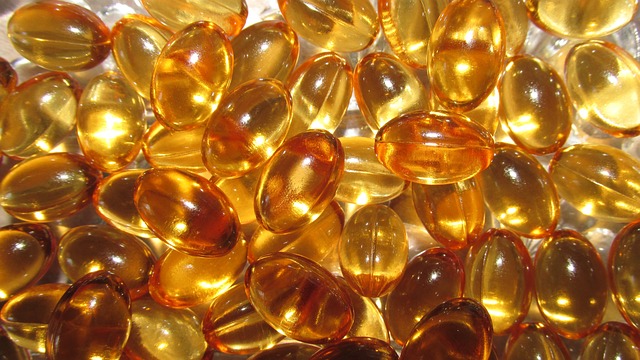Vitamin E

As a fat-soluble vitamin, vitamin E is an important antioxidant in the human body. It comes in a total of eight different varieties, the tocopherols, which include alpha, beta, gamma and delta and the tocotrienols, which also include alpha, beta, gamma and delta varieties. In the human body, alpha-tocopherol is most prevalent and is the most common form found in supplements. The vast majority of the research summarized below has focused on supplementation with alpha-tocopherol.
The recommended daily intake of vitamin E is based on research showing that adequate levels help to maintain red blood cell survival. Doses of 15 mg of vitamin E per day as alpha tocopherol were adequate to prevent red blood cells from dying more frequently due to free radical damage (Horwitt 1956).
Endometriosis, Dysmenorrhea (Painful Menstrual Periods) and Vitamin E
Endometriosis
As a medical condition, endometriosis is a common cause of infertility and pelvic pain in women (Saunders 2021). Endometriosis is defined as the spread of the tissue lining the uterus into the abdominal cavity and beyond. This tissue spread can cause chronic pelvic pain that may be associated with the menstrual cycle, sexual activity, urination and passing stools. And while the condition is common, standard treatments are often poorly effective for symptom relief.
A recent meta-analysis of studies on antioxidant vitamins found that vitamin E was the only vitamin to significantly reduce pelvic pain in endometriosis (Zheng 2023). One of the included clinical trials supplemented vitamin E combined with vitamin C (Amini 2021). Chronic pelvic pain was found to be reduced 81% with the combination. A separate study found more modest results with 43% of women with endometriosis having reduced pain with vitamin E and vitamin C combined (Santanam 2013).
Dysmenorrhea
Dysmenorrhea is defined as pain that occurs during the menstrual cycle, often referred to as menstrual cramps. The pain of dysmenorrhea is usually located in the lower abdomen. In severe cases, dysmenorrhea can be disabling.
A meta-analysis of the research on vitamin E and dysmenorrhea found that vitamin E supplementation can significantly reduce pain, although improvements appear to be modest (Alikamali 2022). As a treatment, vitamin E was typically well tolerated with minimal side effects.
Non-Alcoholic Fatty Liver Disease and Vitamin E
Upwards of 11% of adults worldwide have non-alcoholic fatty liver disease (Ge 2020). The condition can be progressive, with severe cases ending in liver failure and death. Non-alcoholic fatty liver disease causes a build-up of fat in the organ, which can kill liver cells and cause liver scarring. The condition is often related to poor dietary choices and correlates with obesity and diabetes.
For individuals with non-alcoholic fatty liver disease, vitamin E may be helpful. A meta-analysis of the research found that vitamin E reduces liver enzymes, fatty build up and scarring of the liver in patients with the condition (Wang 2023).
Chronic Kidney Disease and Vitamin E

Kidney disease is a common yet often undiagnosed medical condition. Approximately 15% of adults in the U.S. have kidney disease. Of those, only 10% have received a proper diagnosis (CDC 2019). Initial symptoms of kidney disease are few, making it difficult to identify in the early stages without proper testing. While not curative, vitamin E has been shown to significantly reduce inflammation in patients with chronic kidney disease (Supriyadi 2023). Other research suggests that vitamin E may help prevent heart disease and other complications that often occur with the condition (Galli 2022).
Diabetes and Vitamin E
As a general rule, antioxidants often help with blood sugar control. A 2023 analysis on vitamin E in diabetes showed significant benefits (Asbaghi 2023). Vitamin E reduced hemoglobin A1c (a measurement of the average blood sugar level over the last three months), fasting insulin and insulin resistance.
Similar to chronic kidney disease, vitamin E supplementation may also be helpful in preventing complications associated with diabetes. In one small trial, hearing improved in diabetics given a combination of vitamin C and vitamin E as compared to placebo (Merkhan 2019). Vitamin E also provides antioxidant support that may be relevant for decreasing the risks of diabetes-related eye disease (Hamayel 2023).
Dementia and Vitamin E
Alzheiner’s disease and dementia are dreaded health conditions that are increasing in incidence. And standard treatment approaches have poor efficacy, serious side effects or both. While the data on vitamin E is not conclusive, it is still worth considering as a potential option.
An analysis of blood levels of vitamin E and dementia risk found a strong correlation between low alpha-tocopherol, cognitive decline and dementia (Ashley 2021). A separate study looking at vitamin E supplementation and Alzehiemer’s disease found that vitamin E supplementation reduced the risk by 19%, although the results did not reach statistical significance (Wang 2021). More studies are needed to confirm if vitamin E is helpful for prevention or treatment of dementia.
Potential Risks Associated with Vitamin E
Vitamin E can increase bleeding risks (Pastori 2013). And while older studies suggested that supplementation may produce a small increase in the risk of death, more recent analyses do not appear to support these concerns when vitamin E is used in reasonable doses (Galli 2017).
Synthetic Vitamin E
Another potential risk, and possible reason for some of the negative studies on vitamin E, could be due to the use of synthetic vitamin E. Some cheaper versions of synthetic vitamin E are composed of an equal mix of the natural form of vitamin E and a synthetic mirror image version not typically found in nature. While there is virtually no direct studies that I could find on the safety of this non-natural form, I generally recommend avoiding it. The synthetic version of vitamin E should be labeled as “DL-alpha tocopherol,” whereas the natural form is just ”D-alpha tocopherol.”
Conclusion
Vitamin E appears to have a number of potential benefits, from supporting liver function to helping decrease the symptoms of endometriosis. As is often true for natural treatments, more research could better help to establish when vitamin E should be considered as a plausible treatment option.



